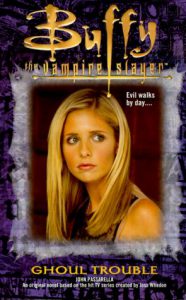John Passarella makes a strong Buffyverse debut (he’d go on to write two “Angel” novels) with “Ghoul Trouble” (October 2000). Set in the spring semester of Season 3, this young-adult entry has a lot of elements that feel like a standalone TV episode, notably a band called Vyxn that plays a five-night stand at the Bronze and has all the male concertgoers under its thrall.
It reminds me of Oz being drawn to Veruca in “Wild at Heart” (4.6), which takes place later but was released before this in the real world. In Passarella’s story, this scantily clad all-girl band is actually an all-ghoul band. (The author clears up a common misconception: Ghouls are not ghosts, they are flesh-eating demons. His description of their natural form made me picture the green vampires from the early issues of the comic book.) This allows for some good writing for Xander, even if the concept of him being drawn to women who turn out to be demons is familiar, and for Willow, who is nearly recruited into the band against her will.
As the two longtime friends are locked up in the ghouls’ lair on page 171, Passarella nicely fleshes out their relationship at this point in time. Xander lets slip that he thinks Willow is pretty, and she admits that she thinks he’s a great guy, too. Since they are in mortal peril, this unusual exchange of honesty – not long after their forbidden kiss causes problems in “Lovers Walk” (3.8) — rings true.
“So you think it?” Willow pressed. “Even if you never say it?”
“Sure, Will, but us being best buds and all, there are many rules and procedures about the not saying of the mushy stuff.”
My only problem with Xander is that he calls Angel “Dead Boy” twice in this story, as he does in nearly every “Buffy” book. It seems like all the authors loved that Xander quip from the TV show, but I think they love it too much. Xander should be more varied with his insults of Angel. Another quibble: The characters broadly pontificate on their life issues up to this point, which seems unnecessary this far into the novel line.
Other than those instances, Passarella’s prose flows nicely. Like a TV episode, he often cuts smoothly to the next scene, giving the effect of a brisk-flowing story. And while “Ghoul Trouble” is a fun read, the author also gives some weight to the stakes. We get a sense of the disgusting nature of the ghouls, who have parts of decomposing corpses around their lair, and the viciousness of the day-walking vampire Solitaire, who puts Giles in the hospital and seriously wounds Angel. Rather than being forgotten by the next chapter, their injuries remain in play throughout the book.
Usually, Buffy and the gang – rather conveniently — face one problem per story, so it’s refreshing that they face two unrelated enemies here. In addition to Vyxn, Solitaire – a vampire who is unharmed by the sun and who has sought out worthy challengers for five centuries – sets his sights on Buffy. The answer to the mystery of how he can walk in the sun is a good one, and it doesn’t clash with the similar story in “The Harsh Light of Day” (“Buffy” 4.3) / “In the Dark” (“Angel” 1.3).

The dual threats also make it logical that Buffy faces Solitaire one-on-one, since the others are occupied with Vyxn. In too many stories, the Scoobies are shorthanded in a fight simply because the other members are at home, not knowing there is a fight; even in the pre-cellphone age, it sometimes feels unlikely.
“Ghoul Trouble’s” place on the timeline is a little wonky, as Buffy is dealing with a guidance counselor who warns her about the possibility of failing classes – sparking worries similar to what’s explored in “Choices” (3.19) — and therefore suggesting that it takes place further along in the spring semester. But it can’t be too much further along, since Giles is still her Watcher, and that relationship ends (at least officially) in “Helpless” (3.12). On the other hand, Willow – before dragging a heavy set of keys across the room using the power of her mind — mentions levitating a pencil, something we see her do in “Doppelgangland” (3.16), so this book almost certainly takes place after that episode.
Although this is certainly not the most problematic book in terms of continuity, problems are becoming less forgivable as the authors get further away from Season 3 in the real world. (Season 5 had started when this book came out.)
While not an essential read, “Ghoul Trouble” features great guest villains and strong writing for all the Scoobs, particularly the oft-brushed-aside Xander, making it a respectable entry.
Click here for an index of all of John’s “Buffy” and “Angel” reviews.

